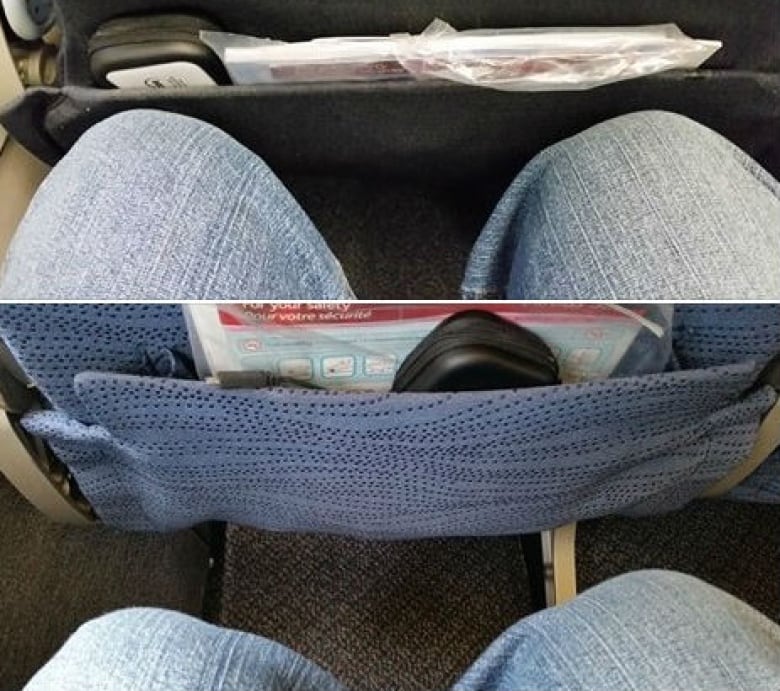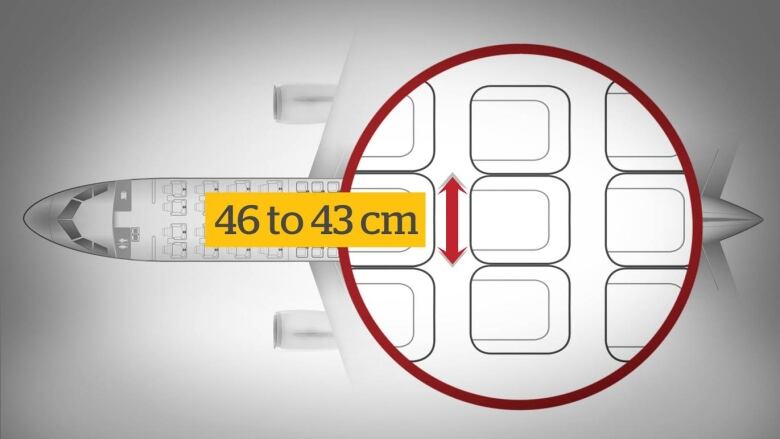Air Canada passenger suffers 'horrible pain' after being stuck in cramped seat
Shrinking passenger area on Canadian airlines a 'public health risk,' says expert

Colin Savage has spent a lifetime staying fit and healthy, but one long airplane flight changed that.
Until recently, the 64-year-old Victoria man would cycle an average of 400 kilometres a week and run marathons. Now he is short of breath and has trouble moving around.
"I have much less energy because I can't take a lot of oxygen in. I'm shuffling around like a senior," Savage told Go Public.
"Doctors in hospital emergency told me that I nearly lost my life."
In January, Savage travelled to Argentina on a hiking trip. The trip home included a 10-hour flight from Chile to Toronto on an Air Canada 777 airplane.

Savage says for most of the flight, passengers were discouraged from getting out of their seats because of turbulence. At 6-2", that was a problem for Savage.
"In their seats, my knees were up against the seat in front of me. I was constantly squirming around trying to get comfortable."
A day and a half after he returned home, he felt a sudden sharp pain in his lower back. When it was still there the next morning he went to a hospital.
"I went through horrible pain, I don't know if you've broken a rib, I have, and this pain was a hundred times worse," Savage says.
- Shrinking airline seats draw attention of U.S. transport committee
- The perils of travellers' thrombosis
Two CT scans later, doctors told Savage he had deep vein thrombosis (DVT), which was likely the result of having to sit for most of the 10-hour flight, and that blood clots had migrated up his leg, through his heart and into his lungs.
What is DVT?
DVT is a condition where a blood clot develops within a deep vein, usually in the thigh or leg. It can break off and make its way to the lungs, where it can cause breathing problems.
According to the World Health Organization, passengers traveling in cramped areas for more than four hours are at risk.

Savage raised the DVT issue with Air Canada and got this response:
"Medical evidence has shown that deep vein thrombosis (DVT) is the result of a pre-existing personal medical condition, related to an individual rather than a transportation system. International courts have confirmed that based on the aforementioned evidence there is no liability to air carriers for DVT that occurs during a flight."
Air Canada told Go Public in an email there is no conclusive medical evidence specifically linking deep vein thrombosis with flying.
"The WHO have advised there is no risk with air travel for healthy passengers, and that long periods of immobility in trains, buses or cars carry similar risk," the airline wrote.
| For information on deep vein thrombosis and how to avoid it, visit the World Health Organization website. |
'Public health risk'

There have been a lot of studies that look at the link between DVT and flying, but not a lot of well done studies, says Dr. James Douketis, the director of vascular medicine at St. Joseph's Healthcare in Hamilton.
"Most are not what we call methodologically rigorous or of a high scientific standard. What that means is, it makes a lot of the results murky," says Douketis, who is also president of Thrombosis Canada.
- Flyers' rights petition demands minimum airplane seat size
- 'Knee defender' passenger 'ashamed' but won't stop using airline seat gadget
"We do know that airline travel increases your risk of blood clots. We know that the longer you travel the higher the risk, and we know that if you have predispositions — like recent surgeries or previous blood clots — your risk is highest."
DVT is the third most common vascular disease next to stroke and heart attack. Douketis says one in 5,000 travellers on long flights are affected.
Air Canada and WestJet combined fly more than 57 million passengers a year. It's not clear how many of those are long-haul flights.
"Even though the risk of a blood clot is low, given the number of people who fly, it became a public health risk," Douketis says.
Air Canada says many of its airplanes now have "slimline seats" that "save cabin space while maintaining the same personal space for passengers."
WestJet tells us it doesn't warn passengers about the risks of DVT and encourages travellers to speak with their doctors before flying.
Seat size shrinking
According to the website seatguru.com, the average distance between seat rows has declined to 79 centimetres, from more than 89 centimetres in the last two decades.

The average seat size is 43 centimetres, down from 46 centimetres.
Seth Kaplan, the editor of Airline Weekly, an online magazine that covers the airline business, says airlines are packing in more seats to make more money.

"In some respects, Canada is very much the epicentre of this densification sensation, of airlines crowding more seats on airplanes ... Both the major airlines, WestJet and Air Canada, have done that," he said.
Kaplan points to a battle in the U.S. to stop the space shrinkage. Earlier this year, a Tennessee congressman introduced an amendment to a Federal Aviation Administration bill that would have mandated the amount of legroom for passengers. In the end, the idea was rejected.
"For airlines it's very simple: this is economics, they have one airplane, same two pilots, same two engines burning about the same amount of fuel, so they can can take those costs and divide them among more seats," Kaplan says.
This side of the border, Canadian passenger advocate Gabor Lukacs is calling for seat size standards in this country.

"I'm not proposing that everyone get more legroom. What I'm talking about is safety issues … how it affects health. Not simply comfort," Gabor says.
As for Savage, he says he is slowly recovering and starting to get his energy back. "The airlines need to take a good hard look at what they're doing and the government needs to lead them in that direction," he said.
Transport Canada does regulate the maximum number of seats allowed on different types of airplanes, but says those numbers are based on safety-related criteria like emergency evacuation times, not design or comfort.
"As long as the air operator meets specific safety-related criteria, they are permitted to install as many seats as they require," Transport Canada spokeswoman Natasha Gauthier tells Go Public.
The federal agency also says it has no plans to review the minimum requirements in seat size or pitch (a measure of leg room), adding "the size of the seat occupied is not known at this time to be a risk factor."
- Read Colin Savage's letter from Transport Canada here.
CBC News Investigates: Stories, videos, photos and more
Submit your story ideas
Go Public is an investigative news segment on CBC-TV, radio and the web.
We tell your stories and hold the powers that be accountable.
We want to hear from people across the country with stories they want to make public.
Submit your story ideas at Go Public.
Follow @CBCGoPublic on Twitter.

